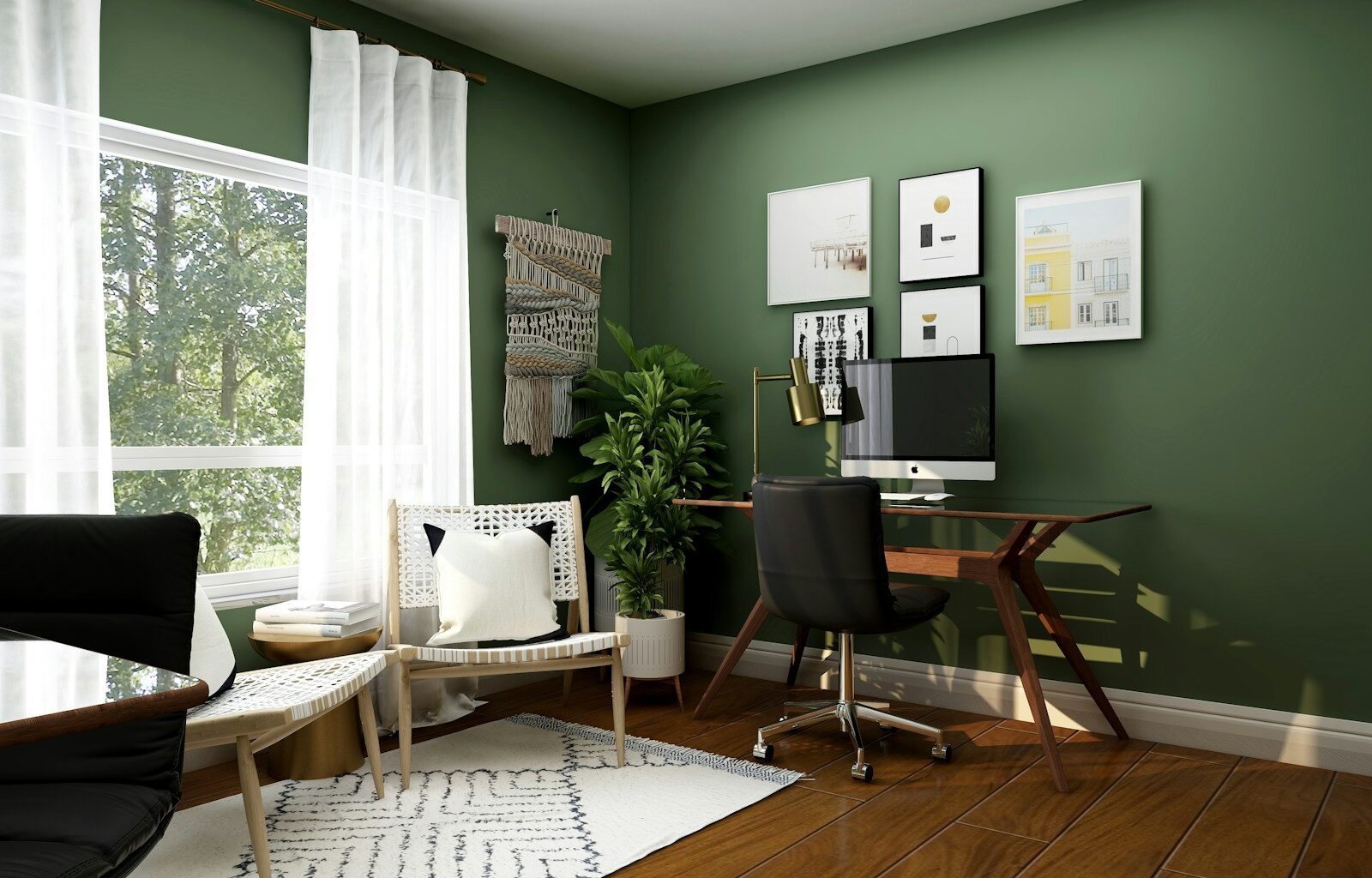Creating an effective home office for $50 or less requires strategic planning and creative solutions that maximize productivity while minimizing costs. Research from Stanford University shows that well-organized home offices increase productivity by 23% while reducing work-related stress by 31%, proving that thoughtful design matters more than expensive equipment for work performance and satisfaction.
1. Workspace Foundation and Desk Solutions
1.1 DIY Desk Construction from Affordable Materials
Build a sturdy desk using a hollow-core door ($25-30) supported by filing cabinets, storage cubes, or sawhorses for less than $40 total. This combination provides ample workspace and integrated storage while costing 75% less than comparable commercial desks.
1.2 Repurposed Furniture and Creative Alternatives
Transform existing furniture—dining tables, console tables, or large dressers—into functional workspaces through creative arrangement and minor modifications. Adding a glass or plywood top protects surfaces while creating smooth work areas.
1.3 Wall-Mounted and Space-Saving Designs
Wall-mounted fold-down desks conserve space in small areas while providing full workspace when needed. Simple brackets and a board create functional desks for under $25 while preserving room flexibility for other uses.
1.4 Height Adjustment and Ergonomic Considerations
Use risers, books, or adjustable legs to achieve proper desk height for comfortable typing and reduce strain. Proper desk height (elbows at 90 degrees) prevents repetitive stress injuries and improves work comfort significantly.
2. Seating Solutions and Posture Support
2.1 Budget Chair Upgrades and Modifications
Improve existing chairs through cushions, lumbar support pillows, and seat adjustments that cost $10-15 while providing ergonomic benefits comparable to expensive office chairs. Focus on back support and proper height for maximum comfort.
2.2 Alternative Seating and Active Options
Exercise balls, standing desk converters, or balance boards provide active seating options that improve posture and core strength while costing less than traditional office chairs. These alternatives also offer health benefits through increased movement.
2.3 DIY Cushions and Support Systems
Create custom lumbar support and seat cushions using foam, fabric, and basic sewing skills for under $10. Personalized cushions provide better fit and comfort than generic options while allowing color and style customization.
2.4 Posture Awareness and Movement Integration
Set reminders for posture checks and movement breaks that cost nothing while providing significant health benefits. Regular position changes and stretching prevent the negative effects of prolonged sitting.
3. Organization Systems and Storage Solutions
3.1 Vertical Storage and Wall Organization
Install floating shelves, pegboards, or wall-mounted organizers for under $20 to maximize storage without consuming desk space. Vertical organization keeps supplies accessible while maintaining clean, uncluttered work surfaces.
3.2 Repurposed Container Organization
Use jars, boxes, and containers you already own to organize office supplies, cables, and materials. This approach costs nothing while creating customized organization systems that fit your specific needs and space constraints.
3.3 Paper Management and Filing Systems
Create filing systems using cardboard magazine holders, binders, or repurposed boxes that organize documents effectively for under $10. Good paper management prevents lost documents and reduces work-related stress significantly.
3.4 Cable Management and Technology Organization
Use cable ties, adhesive hooks, and cord organizers to manage technology cables and prevent workspace clutter. Organized cables improve safety, aesthetics, and functionality while costing less than $5 for complete management.
4. Lighting Optimization for Productivity
4.1 Natural Light Maximization
Position your workspace to take advantage of natural light while avoiding screen glare through window positioning and adjustable blinds. Natural light improves mood, reduces eye strain, and supports healthy circadian rhythms at no cost.
4.2 Task Lighting Solutions
Add focused lighting through desk lamps, clip-on lights, or LED strips that provide adequate illumination for detailed work. Good task lighting reduces eye strain and improves work accuracy while costing $15-25 for quality options.
4.3 Ambient Lighting and Mood Enhancement
Create comfortable ambient lighting through string lights, floor lamps, or candles that improve workspace atmosphere and reduce harsh lighting contrasts. Proper ambient lighting supports extended work sessions and reduces fatigue.
4.4 Light Color and Temperature Considerations
Choose lighting that provides appropriate color temperature—cooler light for focus, warmer light for relaxation—to support different work activities and times of day. LED bulbs offer adjustable options that optimize productivity throughout work sessions.
5. Technology Setup and Equipment Management
5.1 Monitor and Display Optimization
Elevate laptop screens or monitors to eye level using books, risers, or adjustable stands that prevent neck strain while improving posture and visibility. Proper screen height significantly reduces physical stress during extended computer use.
5.2 Keyboard and Mouse Ergonomics
Position keyboards and mice at proper heights and angles to prevent wrist strain and repetitive stress injuries. External keyboards and mice for laptops improve ergonomics significantly while costing $20-30 for quality options.
5.3 Power Management and Accessibility
Use power strips and extension cords to ensure adequate electrical access while organizing power cables safely. Good power management prevents equipment damage while maintaining clean, organized work areas.
5.4 Backup and Data Protection Systems
Implement simple backup systems using cloud storage, external drives, or automated backup software to protect important work and personal data. Basic backup solutions prevent catastrophic data loss while costing little or nothing to implement.
6. Environmental Comfort and Air Quality
6.1 Temperature Control and Ventilation
Optimize workspace temperature through fans, space heaters, or ventilation improvements that maintain comfortable working conditions year-round. Proper temperature control improves focus, productivity, and physical comfort during work sessions.
6.2 Indoor Plants and Air Purification
Add low-cost plants like pothos, spider plants, or snake plants that improve air quality while providing natural beauty and stress reduction. Plants remove toxins from indoor air while creating more pleasant, productive work environments.
6.3 Noise Management and Sound Control
Use soft furnishings, background music, or noise-blocking techniques to create appropriate acoustic environments for focused work. Sound control improves concentration while reducing distractions from household or neighborhood noise.
6.4 Humidity and Air Quality Monitoring
Maintain appropriate humidity levels through houseplants, humidifiers, or ventilation adjustments that prevent dry air problems while supporting respiratory health and comfort during long work sessions.
7. Personalization and Motivation Elements
7.1 Visual Inspiration and Goal Setting
Display motivational images, goals, or achievements that inspire and focus your work efforts. Personal inspiration costs nothing while providing psychological benefits that improve work satisfaction and performance.
7.2 Color Psychology and Mood Enhancement
Use colors that promote productivity and well-being through paint samples, fabric, or accessories. Blue promotes focus, green reduces eye strain, and yellow stimulates creativity—strategic color use improves work performance naturally.
7.3 Personal Touches and Comfort Items
Include meaningful objects, photos, or personal items that make your workspace feel comfortable and uniquely yours. Personal touches improve work satisfaction while creating emotional connection to your work environment.
7.4 Flexibility and Adaptability Features
Design your workspace to adapt to different work activities and changing needs through modular organization and flexible furniture arrangements. Adaptable spaces support various work styles while maximizing limited space and resources.
Conclusion
Creating a productive home office for $50 requires creativity, planning, and strategic resource use, but provides significant returns through improved productivity, reduced stress, and better work-life balance. Focus on essential elements—functional workspace, comfortable seating, adequate












